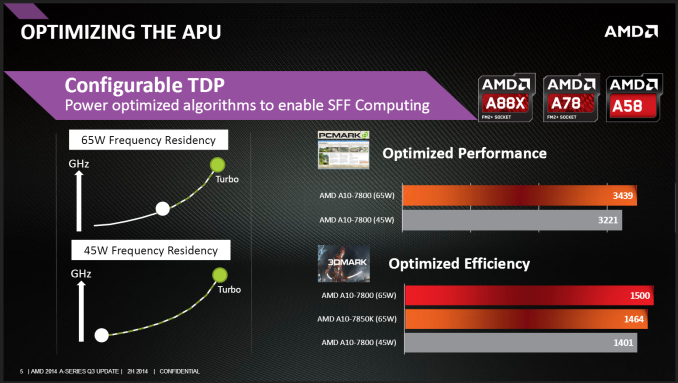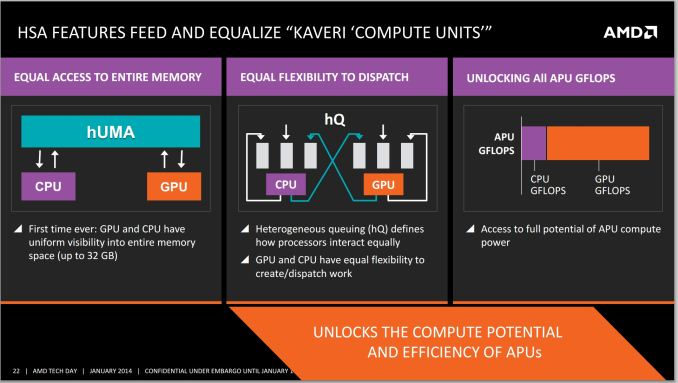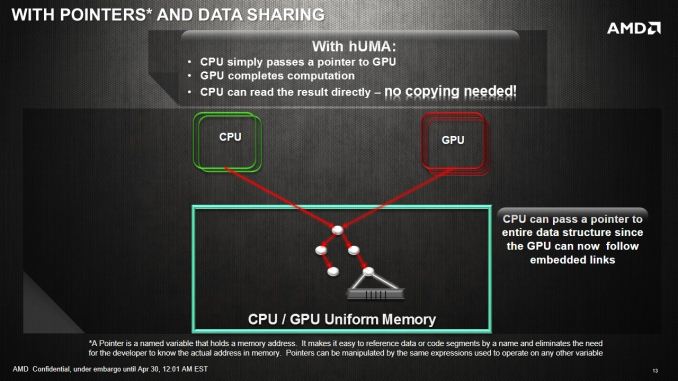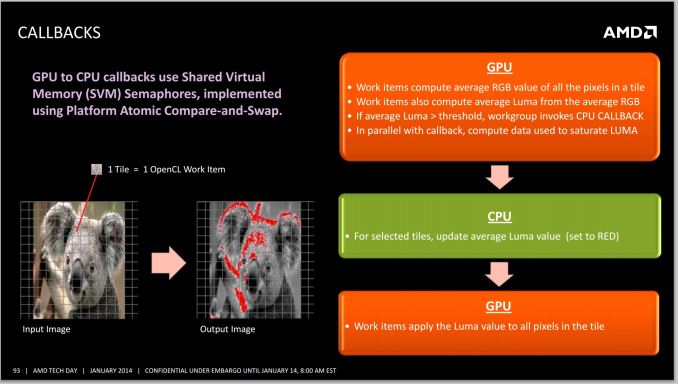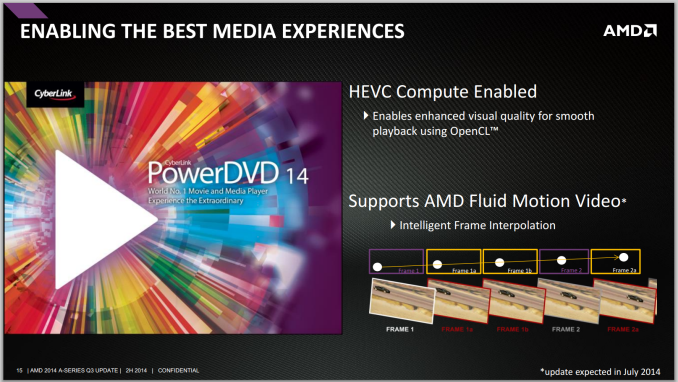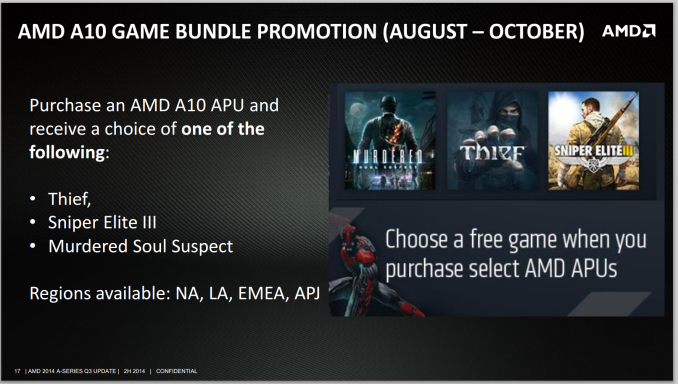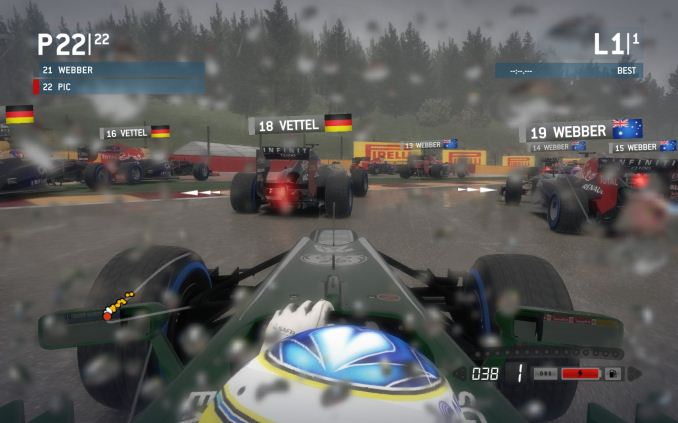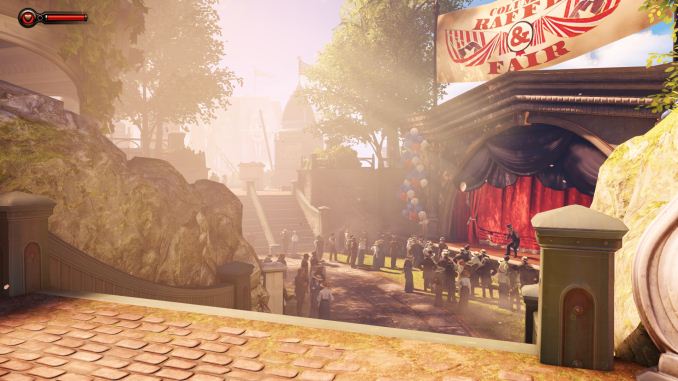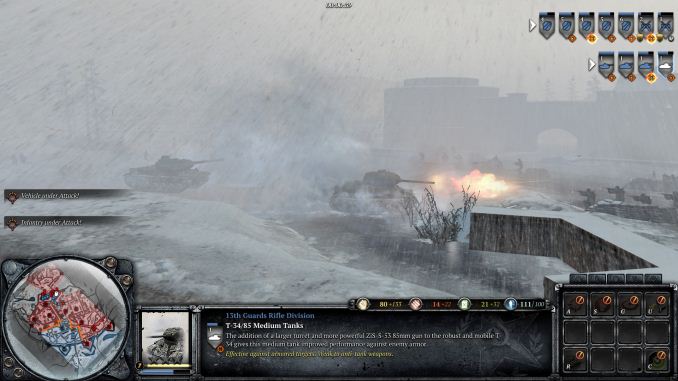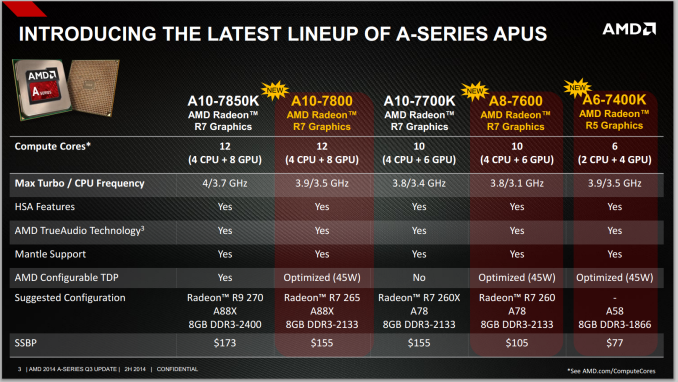
Original Link: https://www.anandtech.com/show/8291/amd-a10-7800-review-65w-kaveri
AMD A10-7800 Review: Testing the A10 65W Kaveri
by Ian Cutress on July 31, 2014 8:00 AM EST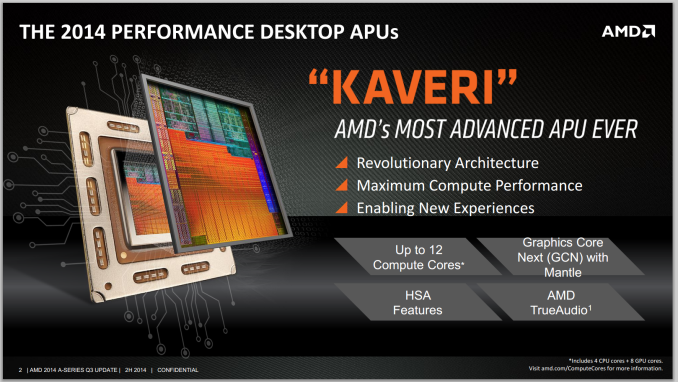
AMD A10-7800 Review: Testing the A10 65W Kaveri
Kaveri was launched as a processor line, on desktop, back in January 2014. At the time we were given information on three of the APUs, the A10-7850K, A10-7700K and A8-7600, and reviewed two of them, including the A8-7600 65W processor. However, at the time, AMD stated that the model we tested was to come out at a later date: that date is today, in a trio of 65W parts. The A10-7800 we are testing today is the locked down version of the A10-7850K, with a slight speed reduction to hit 65W as well as a configurable TDP to 45W.
The Drive to Lower TDP
Previous AMD APU releases have often come with a flurry of processors up and down the price range. Back with the Llano cores and the FM1 platform, two processors were released in the first month followed by six the next and six more by the end of the 2011. With Trinity, it was a similar story: four processors in the first two months, then ten more by the end of the 2012. Richland had eight processors at launch, then other 8 by the end of 2013 and three more for 2014. This is what makes Kaveri a little different: two 95W processors at launch at the start of 2014, and three 65W for July 2014, six months later. Not only is this a large time gap between expanding the processor range, but also a small number of SKUs. That being said, CPU-World lists another 65W APU for release after this trio, and then no more Kaveri until the end of the year when four ‘PRO’ (aka ‘Business Class’) models enter the arena.
Having your mainstream platform headed up by two 95W APUs of the latest generation architecture for so long does nothing for the low power crowd, and AMD’s official reasons for delaying the launch of their 65W parts is due to the lower power message AMD wants to convey, especially in terms of configurable TDP.
Each of the new 65W parts released today has two modes of operation. Out of the box, they will run in 65W mode, using a restricted range of processor frequency in the faster end of operation but with ultimately less efficiency. With an adjustment in the BIOS, they will operate at 45W, which will adjust the base frequency of the processor, relying more on turbo for single threaded workloads. AMD’s numbers above quote a 6-7% dip in performance for a 31% drop in TDP.
If we consider Intel's strategy and AMD's older strategy into the mix, CPU manufacturers would release two processors, one at 45W and one at 65W, in order to offer this difference. That way each die could be tuned for frequency or voltage, as well as processor graphics residency. For whatever reason, AMD decided to consolidate the differing power options, perhaps in order to reduce the number of SKUs on the shelves and make the customer’s choice an easier one.
But therein lies an issue. The number of users prepared to go into the BIOS and adjust the frequency is slim at best, which leads on to system integrators to implement this change in the units they sell. But which system integrators are going to sell products to their customers that do not perform at the maximum performance? It only works when the APU is for a specific design, like an off-the-shelf HTPC or digital signage. The other implementation could be that in order to make the product stack work, it helps to have a few SKUs such that everyone pays more even if they use less – having 45W APUs in the stack might drive sales away from the higher performing models.
The New APUs
AMD’s nomenclature on Compute Cores sums up the number of CPU threads and the number of Compute Units in the processor graphics to give a total number. The previous APUs released were rated at 12 compute cores (A10-7850K) and 10 compute cores (A10-7700K), and the new APUs released today have 12 (A10-7800), 10 (A8-7600) and 6 (A6-7400).
| AMD Kaveri APUs | |||||
| A10-7850K | A10-7800 | A10-7700K | A8-7600 | A6-7400K | |
| TDP | 95W | 65W | 95W | 65W | 65W |
| Compute Cores |
4 CPU + 8 GPU |
4 CPU + 8 GPU |
4 CPU + 6 GPU |
4 CPU + 6 GPU |
2 CPU + 4 GPU |
| Modules / Threads | 2 / 4 | 2 / 4 | 2 / 4 | 2 / 4 | 1 / 2 |
| Base Frequency | 3700 | 3500 | 3400 | 3100 | 3500 |
| Turbo Frequency | 4000 | 3900 | 3800 | 3800 | 3900 |
| L1 Cache |
192 KB I$ 64 KB D$ |
192 KB I$ 64 KB D$ |
192 KB I$ 64 KB D$ |
192 KB I$ 64 KB D$ |
96 KB I$ 32 KB D$ |
| L2 Cache | 4 MB | 4 MB | 4 MB | 4 MB | 1 MB |
| Graphics | R7 | R7 | R7 | R7 | R5 |
| GPU Cores | 512 | 512 | 384 | 384 | 256 |
| GPU Clock | 720 | 720 | 720 | 720 | 756 |
| Max DDR3 | 2133 | 2133 | 2133 | 2133 | 1866 |
| SSRP | $173 | $155 | $155 | $105 | $77 |
One might imagine that AMD would at some point offer APUs at the same frequency with the same name but without the ‘K’ monitor for overclocking, but the distinct numbering difference is occompanied by the respective frequency adjustments. In this case, the A10-7800 is 200 MHz less on the base frequency than the A10-7850K but +100 MHz over the A10-7700K.
AMD confirmed with us after the initial press call the number of streaming processors in the processor graphics, as well as their frequencies. Based on these numbers, the two 78xx APUs have the full complement at 720 MHz, with the 77xx and 76xx reducing down to 6 compute cores. The A6-7400K is interesting in that the frequency is increased to 756 MHz, perhaps indicating that removing one of the CPU modules and half the IGP gives them extra room to play with for frequency. The A6 model does have another metric to set it apart – official memory support is down to DDR3-1866. This differentiation was also present on the Richland 65W A6 and Trinity 65W A6 processors as well.
| AMD 65W Bulldozer Based APUs | ||||||||
| Trinity | Richland | Kaveri | ||||||
| Model |
A6- 5400K |
A8- 5500 |
A10- 5700 |
A8- 6500 |
A10- 6700 |
A10- 7800 |
A8- 7600 |
A6- 7400K |
| Microarchitecture | Piledriver | Steamroller | ||||||
| Socket | FM2 | FM2+ | ||||||
|
Modules / Threads |
1 / 2 | 2 / 4 | 1 / 2 | |||||
| CPU Base Freq | 3600 | 3200 | 3400 | 3500 | 3700 | 3500 | 3100 | 3500 |
| Max Turbo | 3800 | 3700 | 4000 | 4100 | 4300 | 3900 | 3800 | 3900 |
| TDP | 65W | |||||||
| L1 C$ | 64/32 |
128 KB C$ 64 KB D$ |
192 KB C$ 64 KB D$ |
96/32 | ||||
| L2 C$ | 1 MB | 2 x 2 MB | 1 MB | |||||
| Graphics |
HD 7540D |
HD 7560D |
HD 7660D |
HD 8570D |
HD 8670D |
R7 | R7 | R5 |
| GPU Cores | 192 | 256 | 384 | 256 | 384 | 512 | 384 | 256 |
| GPU Clock | 760 | 760 | 760 | 800 | 844 | 720 | 720 | 756 |
| Max DDR3 | 1866 | 1866 | 1866 | 1866 | 1866 | 2133 | 2133 | 1866 |
| Current Price | $60 | $99 | N/A | $119 | N/A | $155 | $105 | $77 |
Kaveri APU Features
In our initial Kaveri coverage and review of the A10-7850K, AMD spent a large amount of time with the press going over their new features for the Kaveri line of APUs. At the time, Mantle support was the big headline, along with HSA (Heterogeneuous System Architecture) that afforded several compute features which could accelerate certain workloads.
Rahul’s deep dive on HSA is well worth a read, beyond my simple coverage here. The main principles allow the processor threads and integrated graphics to both access the same areas of DRAM (known as a Unified Memory Architecture) without expensive memory copies and maintaining the data structure.
With heterogeneous queuing, both the CPU threads and integrated graphics can generate extra work for the other, allowing for dynamic asynchronous compute.
These features, along with working with software developers to optimize their workflow, allow AMD to quote improvements. In our PR pack with this launch AMD is quoting up to 69% faster upscaling in Adobe Photoshop CC for A10 vs. i5, up to 7x faster in LibreOffice for A8 vs. i3, and up to 65% faster JPEG decoding time on A6 vs. Pentium.
For gaming, alongside Mantle support due to the use of GCN, AMD has also implemented the TrueAudio DSP on the Kaveri APU line. Rather than use CPU power or shaders for complex directional audio affects, the DSP is designed to speed these up and reduce stress on other components of the system for better frame rates. The two games being quoted for TrueAudio are Thief and Lichdom Battlemage.
The other feature using the GCN cores is HEVC Compute support with PowerDVD 14, using OpenCL to speed up decoding for high definition content. With a soon-to-be released update, AMD Fluid Motion Video should also be supported.
Launch Deal
With the launch of the 65W APUs, AMD is going to run a promotion for any user purchasing an A10 between August and October – purchase an A10 APU and have a choice of a free game between Thief, Sniper Elite III and Murdered Soul Suspect.
Test Setup
As these APUs are still part of the Kaveri line, they should work with any FM2+ motherboard, although depending on the motherboard manufacturer it may require a BIOS update. We suggest that you contact the retailer to ensure that the motherboard BIOS is up to date and compatible with the new APU.
| Test Setup | |
| Processor |
AMD A10-7800 2 Modules, 4 Threads |
| Motherboards | MSI A88X-G45 Gaming |
| Cooling |
Corsair H80i Thermalright TRUE Copper |
| Power Supply | OCZ 1250W Gold ZX Series |
| Memory | 2 x Corsair Vengeance Pro 2x8 GB DDR3-2400 10-12-12 Kit |
| Memory Settings | 2133 8-9-9 |
| Video Cards | MSI GTX 770 Lightning 2GB (1150/1202 Boost) |
| Video Drivers |
Catalyst 14.3 NVIDIA Drivers 337 |
| Hard Drive | OCZ Vertex 3 256GB |
| Optical Drive | LG GH22NS50 |
| Case | Open Test Bed |
| Operating System | Windows 7 64-bit SP1 |
| USB 2/3 Testing | OCZ Vertex 3 240GB with SATA->USB Adaptor |
| WiFi Testing | D-Link DIR-865L 802.11ac Dual Band Router |
CPU Benchmarks
The dynamics of CPU Turbo modes, both Intel and AMD, can cause concern during environments with a variable threaded workload. There is also an added issue of the motherboard remaining consistent, depending on how the motherboard manufacturer wants to add in their own boosting technologies over the ones that Intel would prefer they used. In order to remain consistent, we implement an OS-level unique high performance mode on all the CPUs we test which should override any motherboard manufacturer performance mode.
HandBrake v0.9.9: link
For HandBrake, we take two videos (a 2h20 640x266 DVD rip and a 10min double UHD 3840x4320 animation short) and convert them to x264 format in an MP4 container. Results are given in terms of the frames per second processed, and HandBrake uses as many threads as possible.
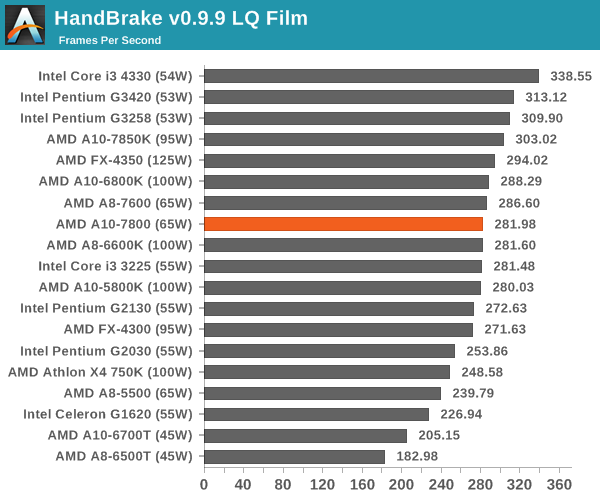
The latest Intel processors have the lead for low quality Handbrake conversion, and despite the generational gap between the FX-4350 and the A10-7800, the extra MHz is preferred here.
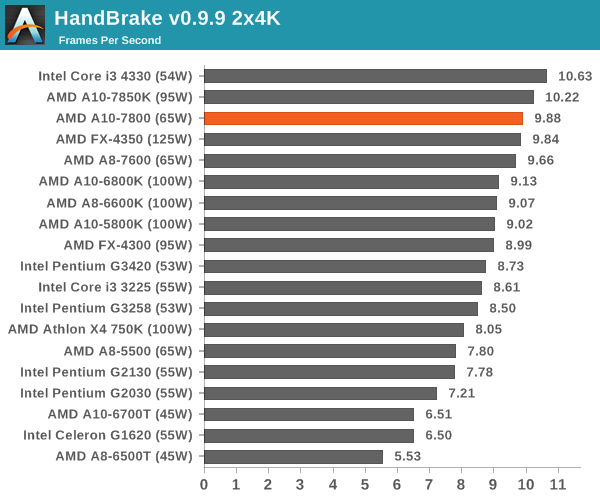
For large frame manipulation, the latest architectures mixed with the most threads perform best.
Agisoft Photoscan – 2D to 3D Image Manipulation: link
Agisoft Photoscan creates 3D models from 2D images, a process which is very computationally expensive. The algorithm is split into four distinct phases, and different phases of the model reconstruction require either fast memory, fast IPC, more cores, or even OpenCL compute devices to hand. Agisoft supplied us with a special version of the software to script the process, where we take 50 images of a stately home and convert it into a medium quality model. This benchmark typically takes around 15-20 minutes on a high end PC on the CPU alone, with GPUs reducing the time.
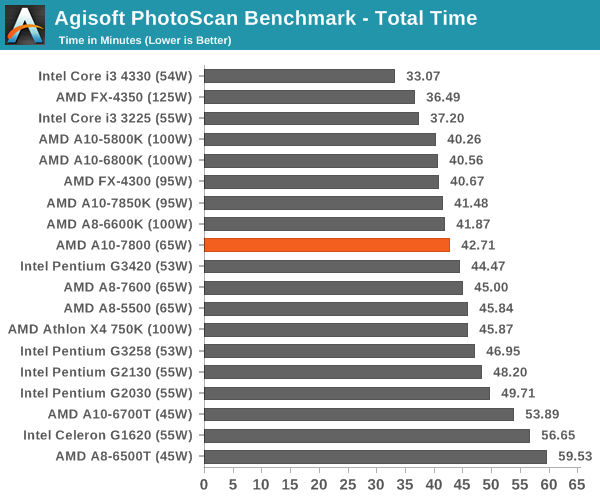
Dolphin Benchmark: link
Many emulators are often bound by single thread CPU performance, and general reports tended to suggest that Haswell provided a significant boost to emulator performance. This benchmark runs a Wii program that raytraces a complex 3D scene inside the Dolphin Wii emulator. Performance on this benchmark is a good proxy of the speed of Dolphin CPU emulation, which is an intensive single core task using most aspects of a CPU. Results are given in minutes, where the Wii itself scores 17.53 minutes.
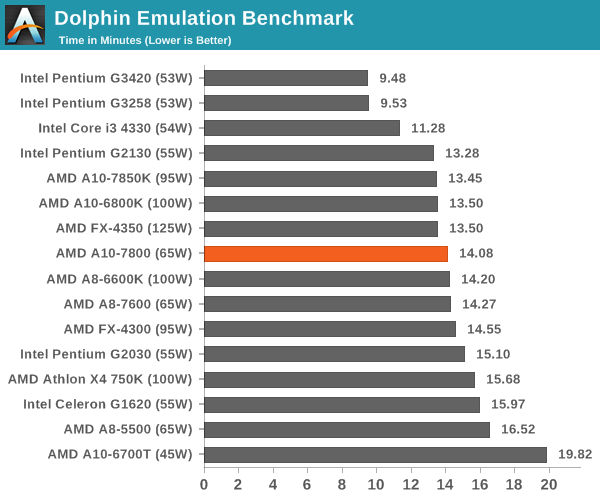
Dolphin seems to work best with high single core speed and Haswell.
WinRAR 5.0.1: link
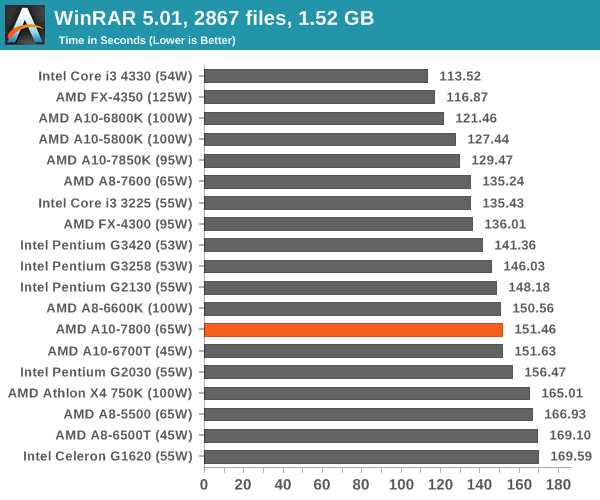
PCMark8 v2 OpenCL on IGP
A new addition to our CPU testing suite is PCMark8 v2, where we test the Work 2.0 and Creative 3.0 suites in OpenCL mode. As this test is new, we have not run it on many AMD systems yet and will do so as soon as we can.
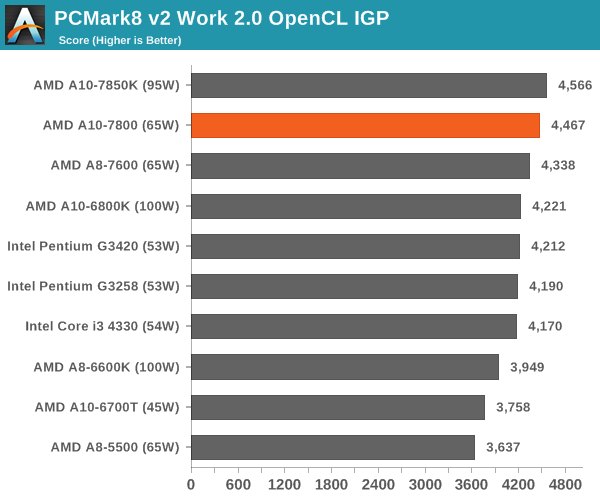
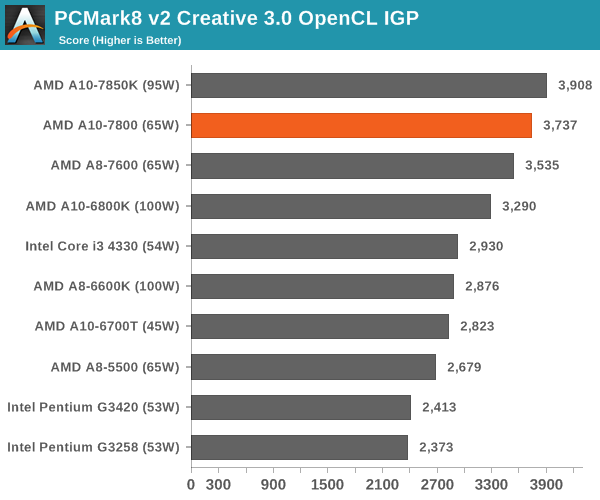
The combination of processor graphics and OpenCL support push the AMD APUs up to the top of our PCMark tests.
Hybrid x265
Hybrid is a new benchmark, where we take a 4K 1500 frame video and convert it into an x265 format without audio. Results are given in frames per second.
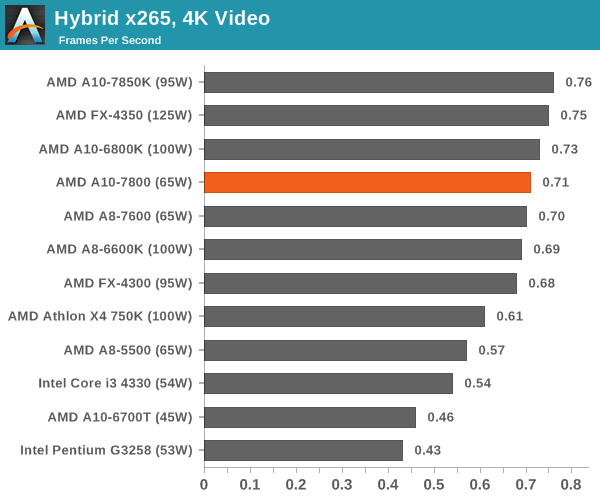
Cinebench R15
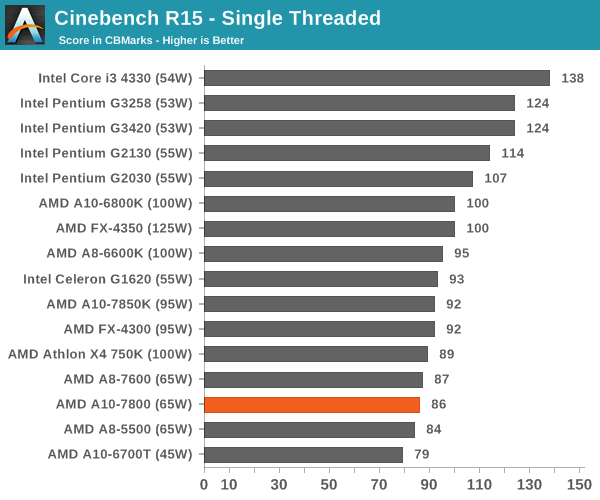
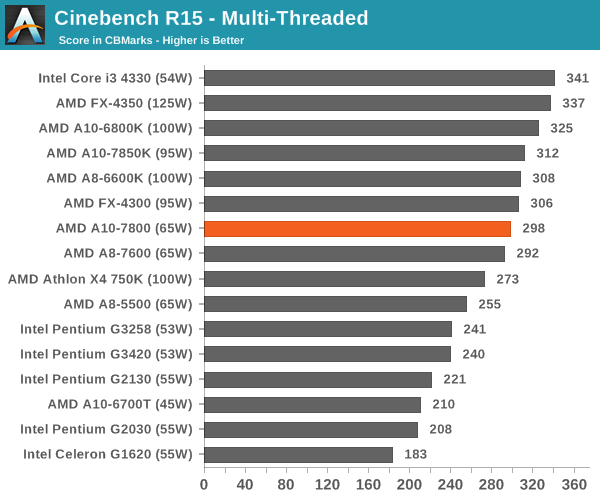
Cinebench is typically Intel territory for high IPC processors, but when it comes to multithreaded rendering, extra threads help.
3D Particle Movement
3DPM is a self-penned benchmark, taking basic 3D movement algorithms used in Brownian Motion simulations and testing them for speed. High floating point performance, MHz and IPC wins in the single thread version, whereas the multithread version has to handle the threads and loves more cores.
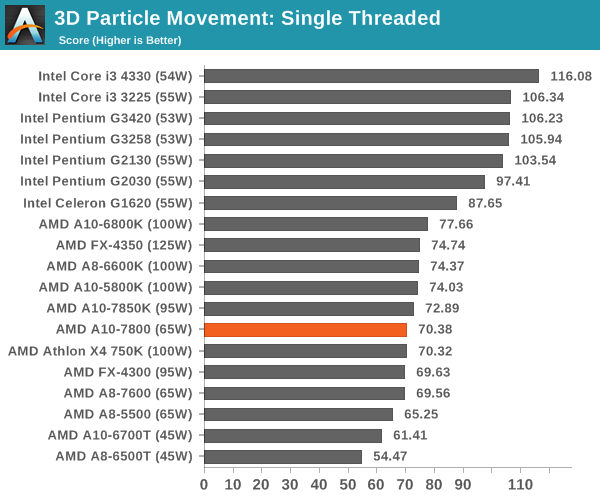
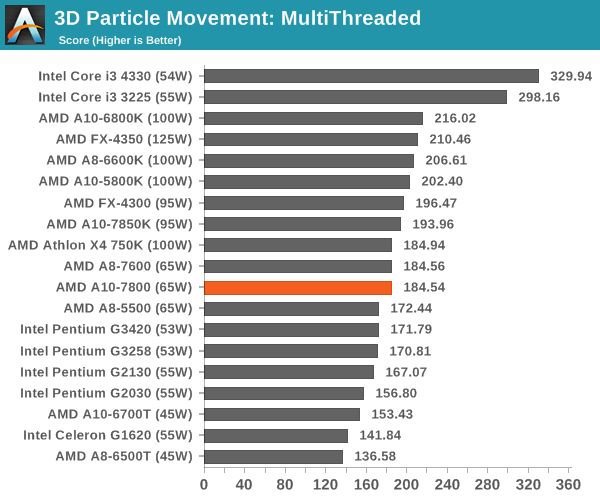
All the calculations in 3DPM deal with floating point numbers, a known sink for AMD compute.
FastStone Image Viewer 4.9
FastStone is the program I use to perform quick or bulk actions on images, such as resizing, adjusting for color and cropping. In our test we take a series of 170 images in various sizes and formats and convert them all into 640x480 .gif files, maintaining the aspect ratio. FastStone does not use multithreading for this test, and results are given in seconds.
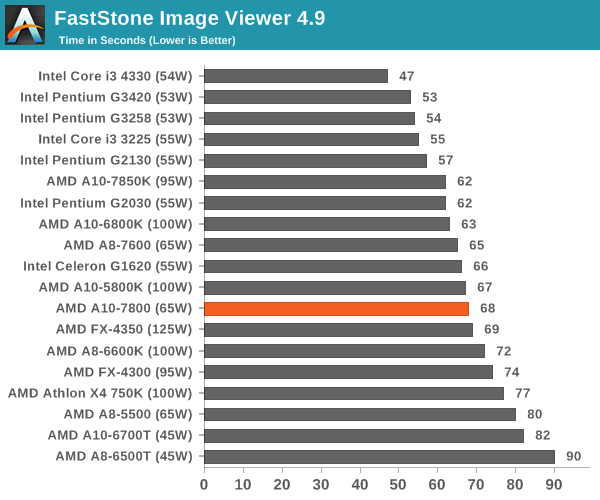
Web Benchmarks
On the lower end processors, general usability is a big factor of experience, especially as we move into the HTML5 era of web browsing. For our web benchmarks, we take four well known tests with Chrome 35 as a consistent browser.
Sunspider 1.0.2
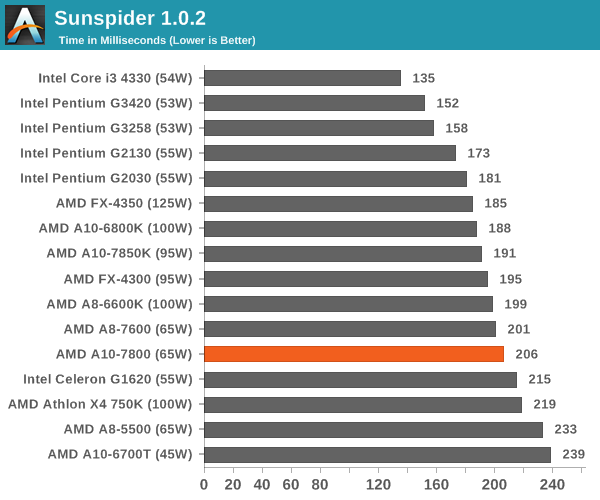
Mozilla Kraken 1.1
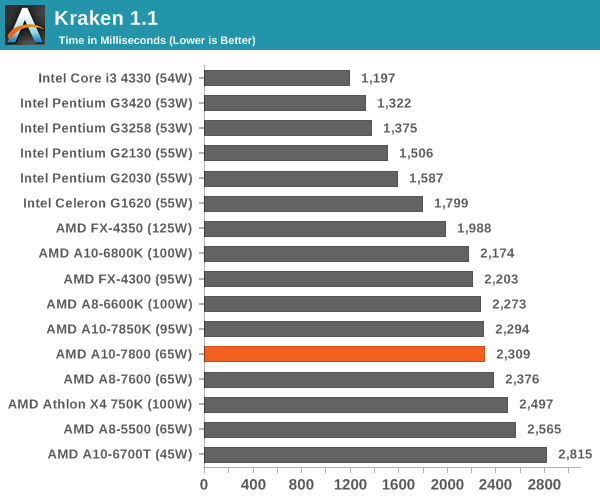
WebXPRT
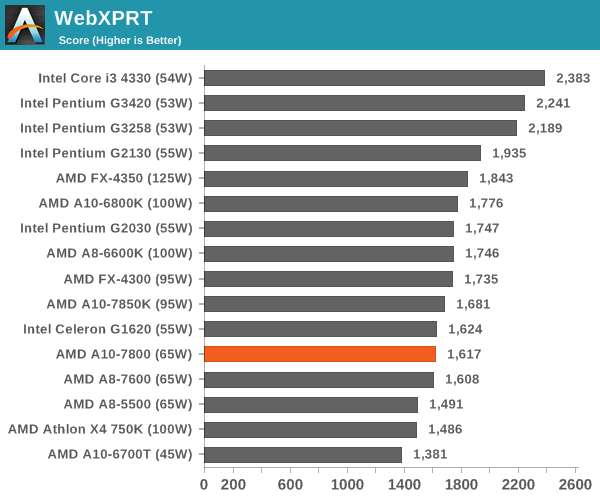
Google Octane v2
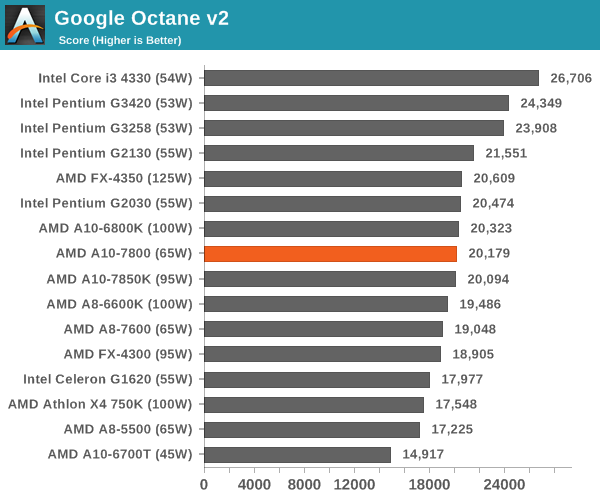
Gaming and Synthetics on Processor Graphics
The faster processor graphics become, the more of the low end graphics market is consumed - if the integrated graphics are better than a $50 discrete GPU, there ends up being no reason to buy a discrete GPU. This might seem a little odd for AMD, who also have a discrete GPU business. The counter argument is that integrated graphics is only comparable to low-end GPUs, which are historically low margin parts and thus might encourage users to invest in larger GPUs, especially as demands in resolution and graphical eye-candy increase. The compute side is also important, and the homologation of discrete to integrated graphics architectures helps software optimised for one also be accelerated on the other.
F1 2013
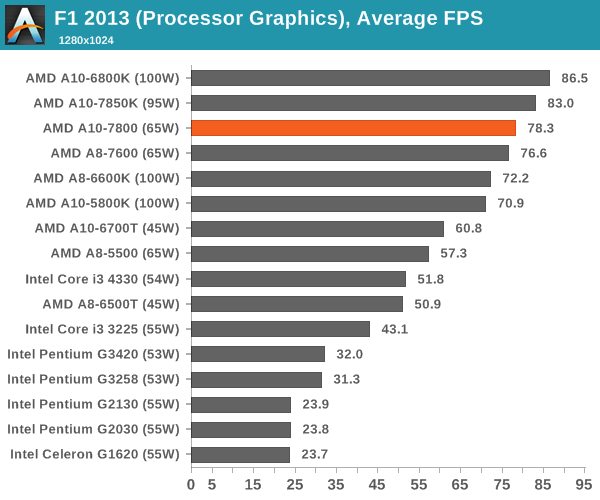
Bioshock Infinite
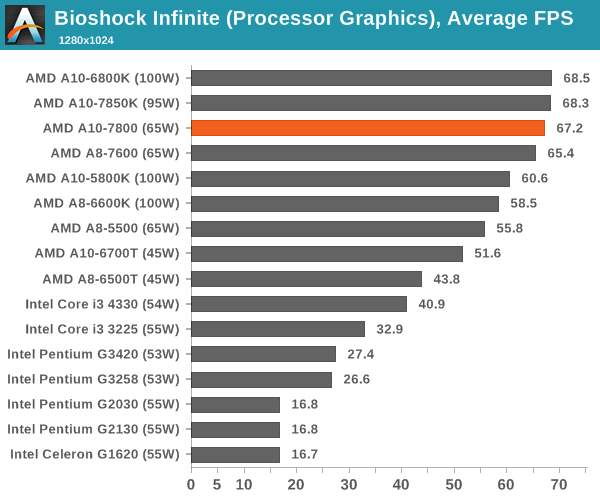
Tomb Raider
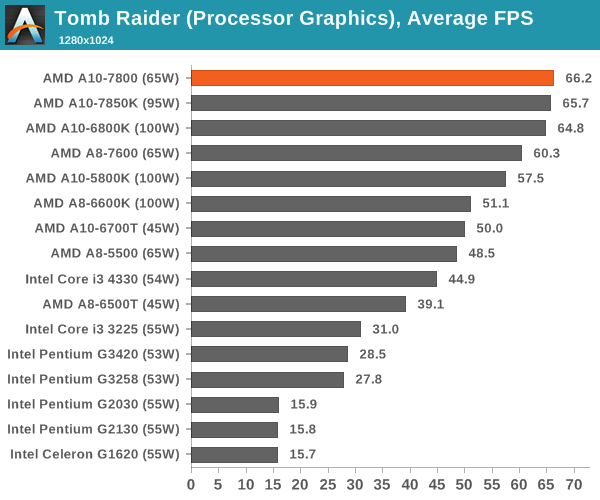
Sleeping Dogs
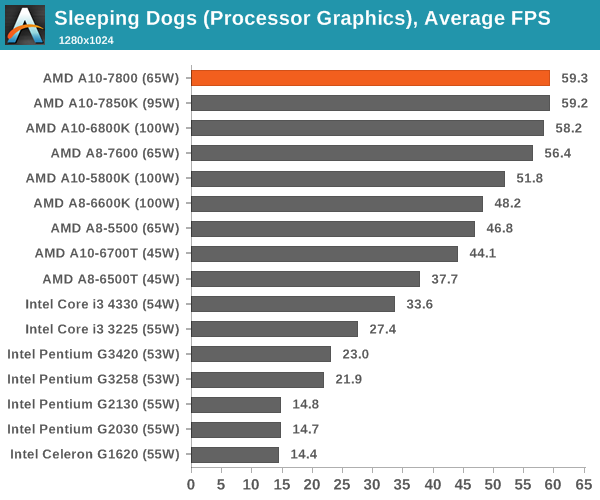
Company of Heroes 2
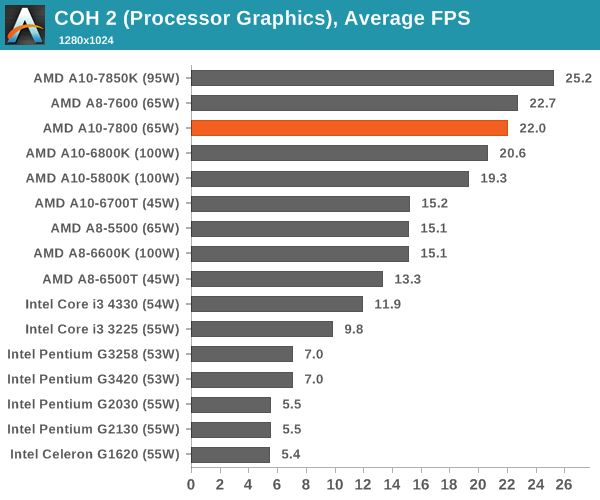
CompuBench 1.5
CompuBench is a new addition to our CPU benchmark suite, and as such we have only tested it on the following processors. The software uses OpenCL commands to process parallel information for a range of tests, and we use the flow management and particle simulation benchmarks here.
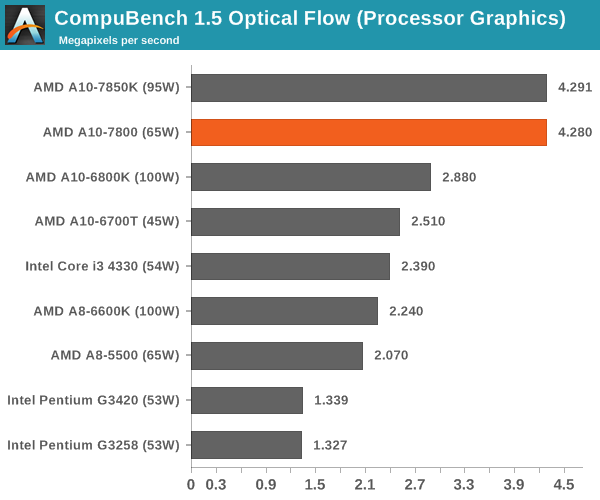
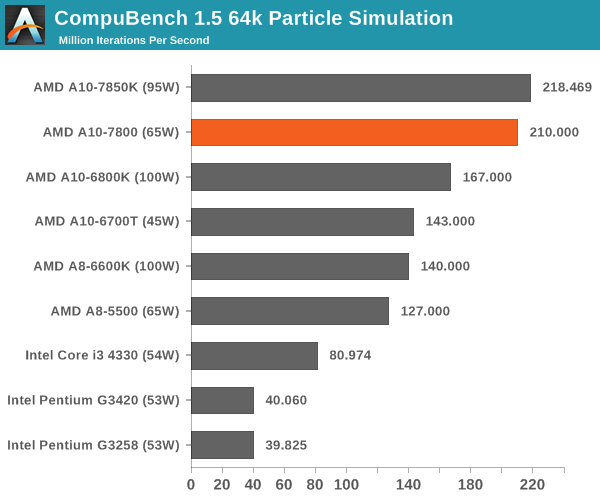
3DMark Fire Strike
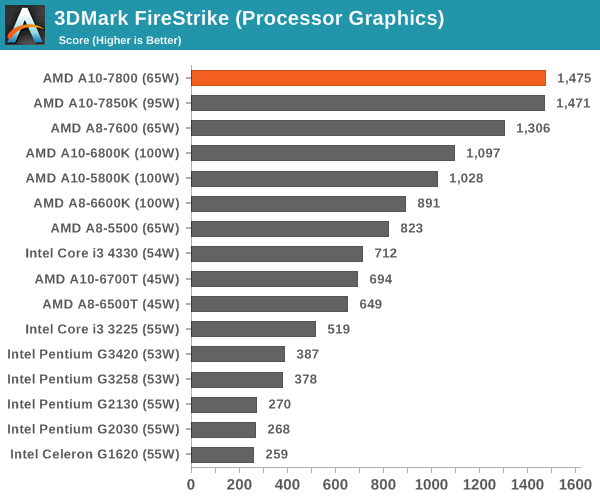
The simple answer is this: for anything related to processor graphics, AMD's Kaveri wins hands down and by a large margin in the same power envelope for cheaper.
Conclusions
When AMD launched their 95W Kaveri APUs and we had the opportunity to test the top A10 model, it offered some of the best integrated graphics performance for a desktop we had seen. The fact that the die is partitioned such that more than 50% of it is for the graphics, along with expanding HSA and OpenCL support, means that for applications that can be computationally enhanced by integrated graphics, AMD has the edge for the single chip solution.
In our testing, because the A10-7800 shares the same processor graphics configuration and speed as the A10-7850K, results were fairly similar despite a +100 MHz advantage to the A10-7850K. This means that, at stock, AMD is offering a similar CPU for $18 less.
If we remove the price from the equation, the biggest contender for the title of ‘best processor graphics’ is Intel’s Iris Pro. The upside of AMD’s Kaveri at the minute is not only the price, but also the form factor – Iris Pro is only available as a soldered on (BGA) CPU at this point in time whereas Kaveri is in both soldered and socketed form. Also, Iris Pro relies on an extra L4 cache, which adds size to the CPU package as well as cost and power consumption. News from Intel might change that with Broadwell, as back in May an announcement regarding a socketed, overclockable Iris Pro CPU would be coming to market. We have not the slightest clue when AMD will have this competition, but it looks good for AMD given that recent reports suggest that Broadwell for the desktop may be delayed beyond the expected launch of 14nm Core-M in Q1 2015.
In that respect, it may give AMD some time to prepare for their new 64-bit x86 architecture, or give AMD another chance to leap forward in with their Carrizo APUs (still based on modules and GCN) if they are launched in 2015.
Back to the A10-7800 reviewed today, and as it stands it is the most cost effective processor graphics solution available. Here is all the speed of the A10-7850K for $18 cheaper, and more performance than the A8-7600. The 45W configurable TDP makes it even more enticing as a lower power consumption part.
The only issue users might come across is the speed and feel when running single threaded tasks that do not utilise OpenCL or HSA – our web benchmarks put the AMD APUs behind many of our 55W Intel samples for the last couple of generations. But for anything that uses OpenCL as an accelerant, such as the software on which PCMark8 is based or anything compute, AMD comes out on top.

